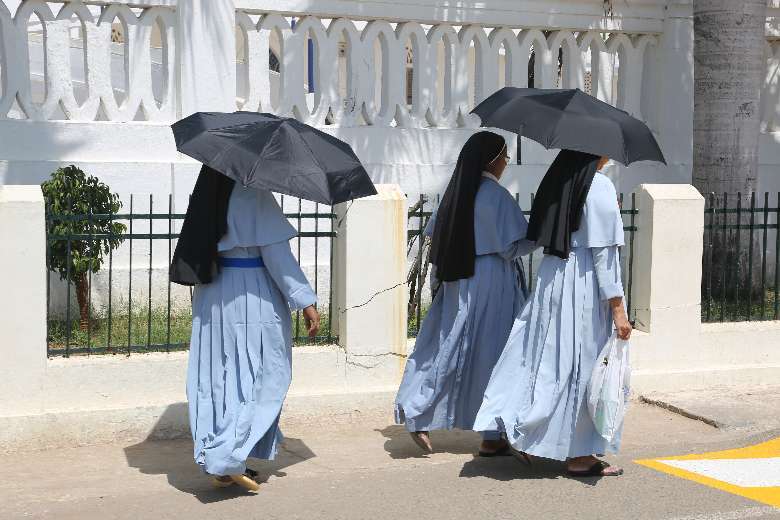MUMBAI (INDIA)
Union of Catholic Asian News (UCA News) [Hong Kong]
September 6, 2021
By Myron Pereira
Will Catholic women lag behind their Dalit, Muslim and Adivasi sisters in challenging patriarchal traditions?
I recently watched a debate at the Oxford Union on why Arab men hate women. Egyptian feminist Mona Eltahawy, who was the main speaker, brought forward numerous instances of women’s oppression in the Muslim Arab world.
These were not unique to Islam, she emphasized. They occur with variations wherever patriarchy holds sway.
The truth is that similar attitudes of patriarchy dominate the Catholic world as women themselves have reiterated for decades.
A recent report commissioned by the Conference of Religious Women in India, “It’s High Time, Women Religious speak up on Gender Justice in the Indian Church,” edited by Hazel D’Lima, Cletus Zuzarte and Pallavi Xalxo, brings this out sharply.
The hierarchy of the Church, the report says, is steeped in patriarchy. This contributes in no small way to its oppression of all women — but to religious sisters in particular.
What actually is patriarchy? Simply put, it is the “rule of the father” — the rule of men at every level, intent on dominating women and keeping them subservient. The activist Rosemary Ruether put it succinctly: “Where God is a man, there men want to play god.”
Patriarchal attitudes are found everywhere — in offices, classrooms, homes, parliament and on the street.
What forms of oppression do Catholic religious sisters suffer from the clergy here in India?
Here are some;
*Verbal abuse (sexist jokes about women in general, and about nuns in particular) and abusive language from the pulpit;
*Refusal to say Mass for religious communities because of some grievance;
*Sundry forms of petty harassment, demanding that the sisters are always at the priests’ beck and call;
*Ignoring the professional competence of sisters, shown particularly in not paying them a commensurate salary for their work, but just a token amount, a stipend;
*Tensions between the hierarchy and sisters’ congregations regarding the ownership, use and transfer of properties.
Brother Philip Pinto, former superior-general of the Christian Brothers, said: “I have heard such stories from sisters over the years and gone through a whole gamut of emotions, from anger to disbelief at male arrogance, to frustration, sorrow and shame. Enough! Now is the call to action!”
The options are many, but it is important that they start from the sisters themselves and are not imposed from without.
The first is education, both religious and professional. Many sisters — like most women in India — have limited general knowledge that usually doesn’t go beyond domestic matters. Many are diffident about holding themselves in public. With proper training, this must change.
Much of what passes for religious formation in the Church is indoctrination and it is important for sisters to realize this.
How does one know that one is being indoctrinated? When there is no freedom to question, to criticize.
For most religious women (and men too) questions arise related to finances, relationships of governance and mission, and sexuality. These are all areas of control where hierarchy resents any questioning of its decisions. This too must change.
The second option is a work environment outside the convent walls so that those religious sisters can experience for themselves the world of the working woman with all its joys and successes, its tensions and harassment.
There’s nothing like professional work to give one a sense of one’s worth and self-respect. It’s an important counterpoint to the pettiness of religious community life.
A third area, unmentioned in the report but increasingly a cause of concern, is the sexual exploitation of religious sisters by the clergy. The pedophile crisis has fractured the western Church and exposed its rottenness.
How do religious sisters protect themselves from predatory priests and bishops in this country with its skewed attitudes to gender equality? We urgently need answers.
In many respects, the Catholic Church lives in a time warp of its own, and many of its major problems are related to this feudal mentality.
While the world outside lives in a democracy with relative freedom of expression, priests and sisters continue to live in systems where the accountability and transparency of their superiors is almost nil, and where human love and sexuality are fiercely repressed.

In several places in the West, such forms of religious life are in a process of disintegration. The Indian situation is peculiar in that it is rigidly authoritarian and pervasively hypocritical. This gives patriarchy in this country certain resilience.
But the world is changing, and changing rapidly. Indian women are speaking out, challenging familial mores, demanding their rights. In many respects, they have shown themselves to be as skilled as men, if not superior.
Will Indian Catholic women lag behind their Dalit, Muslim and Adivasi sisters? It’s high time they broke their silence.
Father Myron Pereira SJ is a media consultant based in Mumbai. The views expressed in this article are those of the author and do not necessarily reflect the official editorial position of UCA News.
